Division of Korea
The Division of Korea began at the end of World War II in 1945. With the declaration of the Soviet–Japanese War, the Soviet Union occupied the north of Korea and the United States occupied the south, with the boundary between their zones being the 38th parallel.
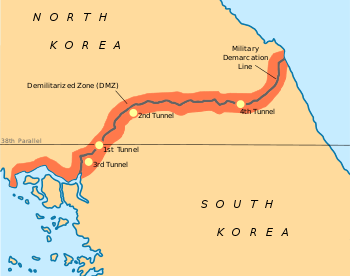

Part of a series on the |
||||||||
|---|---|---|---|---|---|---|---|---|
| History of Korea | ||||||||
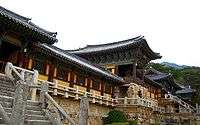 | ||||||||
| Prehistoric period | ||||||||
| Ancient period | ||||||||
|
||||||||
| Proto–Three Kingdoms period | ||||||||
| Three Kingdoms period | ||||||||
|
||||||||
| Northern and Southern States period | ||||||||
|
||||||||
| Later Three Kingdoms period | ||||||||
|
||||||||
| Dynastic period | ||||||||
|
||||||||
| Colonial period | ||||||||
|
||||||||
| Modern period | ||||||||
|
||||||||
| Topics | ||||||||
| Timeline | ||||||||
With the onset of the Cold War, negotiations between the United States and the Soviet Union failed to lead to an independent and unified Korean state. In 1948, UN-supervised elections were held in the US-occupied south only. The American-backed Syngman Rhee won the election while Kim Il-sung was appointed as the leader of North Korea. This led to the establishment of the Republic of Korea in South Korea, which was promptly followed by the establishment of the Democratic People's Republic of Korea in North Korea. The United States supported the South, the Soviet Union supported the North, and each government claimed sovereignty over the whole Korean peninsula.
In 1950, after years of mutual hostilities, North Korea invaded South Korea in an attempt to unify the peninsula under its communist rule. The subsequent Korean War, which lasted from 1950 to 1953, ended with a stalemate and has left the two Koreas separated by the Korean Demilitarized Zone (DMZ) up to the present day.
On April 27, 2018, during the 2018 Inter-Korean Summit, the Panmunjom Declaration for Peace, Prosperity and Reunification of the Korean Peninsula was adopted between the Supreme Leader of North Korea, Kim Jong-un and the President of South Korea, Moon Jae-in. Later that same year, following the September Inter-Korean Summit, several actions were taken toward reunification along the border, such as the dismantling of guard posts and the creation of buffer zones to prevent clashes. On 12 December 2018, soldiers from both Koreas crossed the Military Demarcation Line (MDL) into the opposition countries for the first time in history.[1][2]
Historical background
Japanese rule (1910–1945)
When the Russo-Japanese War ended in 1905 Korea became a nominal protectorate of Japan, and was annexed by Japan in 1910. The Korean Emperor Gojong was removed. In the following decades, nationalist and radical groups emerged to struggle for independence. Divergent in their outlooks and approaches, these groups failed to unite in one national movement.[3][4] The Korean Provisional Government in exile in China failed to obtain widespread recognition.[5]
World War II
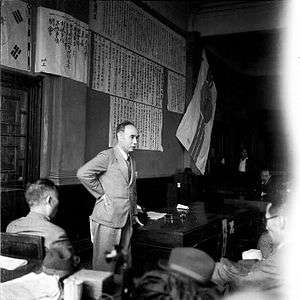
At the Cairo Conference in November 1943, in the middle of World War Two, Franklin D. Roosevelt, Winston Churchill and Chiang Kai-shek agreed that Japan should lose all the territories it had conquered by force. At the end of the conference, the three powers declared that they were, "mindful of the enslavement of the people of Korea, ... determined that in due course Korea shall become free and independent."[6][7] Roosevelt floated the idea of a trusteeship over Korea, but did not obtain agreement from the other powers. Roosevelt raised the idea with Joseph Stalin at the Tehran Conference in November 1943 and the Yalta Conference in February 1945. Stalin did not disagree, but advocated that the period of trusteeship be short.[8][9]
At the Tehran and Yalta Conferences, Stalin promised to join his allies in the Pacific War in two to three months after victory in Europe. On 8 August 1945, two days after the first atomic bomb was dropped on Hiroshima, but before the second bomb was dropped at Nagasaki, the USSR declared war on Japan.[10] As war began, the Commander-in-Chief of Soviet Forces in the Far East, Marshal Aleksandr Vasilevsky, called on Koreans to rise up against Japan, saying "a banner of liberty and independence is rising in Seoul".[11]
Soviet troops advanced rapidly, and the US government became anxious that they would occupy the whole of Korea. On 10 August 1945 two young officers – Dean Rusk and Charles Bonesteel – were assigned to define an American occupation zone. Working on extremely short notice and completely unprepared, they used a National Geographic map to decide on the 38th parallel as the dividing line. They chose it because it divided the country approximately in half but would place the capital Seoul under American control. No experts on Korea were consulted. The two men were unaware that forty years before, Japan and pre-revolutionary Russia had discussed sharing Korea along the same parallel. Rusk later said that had he known, he "almost surely" would have chosen a different line.[12][13] The division placed sixteen million Koreans in the American zone and nine million in the Soviet zone.[14] Rusk observed, "even though it was further north than could be realistically reached by US forces, in the event of Soviet disagreement ... we felt it important to include the capital of Korea in the area of responsibility of American troops". He noted that he was "faced with the scarcity of US forces immediately available, and time and space factors, which would make it difficult to reach very far north, before Soviet troops could enter the area".[15] To the surprise of the Americans, the Soviet Union immediately accepted the division.[11][16] The agreement was incorporated into General Order No. 1 (approved on 17 August 1945) for the surrender of Japan.[16]
Soviet forces began amphibious landings in Korea by 14 August and rapidly took over the north-east of the country, and on 16 August they landed at Wonsan.[17] On 24 August, the Red Army reached Pyongyang, the second largest city in Korea.[16]
General Nobuyuki Abe, the last Japanese Governor-General of Korea, had established contact with a number of influential Koreans since the beginning of August 1945 to prepare the hand-over of power. Throughout August, Koreans organized people's committee branches for the "Committee for the Preparation of Korean Independence" (CPKI), led by Lyuh Woon-hyung, a left-wing politician. On 6 September 1945, a congress of representatives was convened in Seoul and founded the short-lived People's Republic of Korea.[18][19] In the spirit of consensus, conservative elder statesman Syngman Rhee, who was living in exile in the US, was nominated as President.[20]
Post-World War II
Soviet occupation of northern Korea
When Soviet troops entered Pyongyang, they found a local branch of the Committee for the Preparation of Korean Independence operating under the leadership of veteran nationalist Cho Man-sik.[21] The Soviet Army allowed these "People's Committees" (which were friendly to the Soviet Union) to function. In September 1945, the Soviet administration issued its own currency, the "Red Army won".[11] In 1946, Colonel-General Terentii Shtykov took charge of the administration and began to lobby the Soviet government for funds to support the ailing economy.[11]
In February 1946 a provisional government called the Provisional People's Committee was formed under Kim Il-sung, who had spent the last years of the war training with Soviet troops in Manchuria. Conflicts and power struggles ensued at the top levels of government in Pyongyang as different aspirants manoeuvred to gain positions of power in the new government. In March 1946 the provisional government instituted a sweeping land-reform program: land belonging to Japanese and collaborator landowners was divided and redistributed to poor farmers.[22] Organizing the many poor civilians and agricultural labourers under the people's committees, a nationwide mass campaign broke the control of the old landed classes. Landlords were allowed to keep only the same amount of land as poor civilians who had once rented their land, thereby making for a far more equal distribution of land. The North Korean land reform was achieved in a less violent way than in China or in Vietnam. Official American sources stated: "From all accounts, the former village leaders were eliminated as a political force without resort to bloodshed, but extreme care was taken to preclude their return to power."[23] The farmers responded positively; many collaborators, former landowners and Christians fled to the south, where some of them obtained positions in the new South Korean government. According to the U.S. military government, 400,000 northern Koreans went south as refugees.[24]
Key industries were nationalized. The economic situation was nearly as difficult in the north as it was in the south, as the Japanese had concentrated agriculture and service industries in the south and heavy industry in the north.
Soviet forces departed in 1948.[25]
US occupation of southern Korea
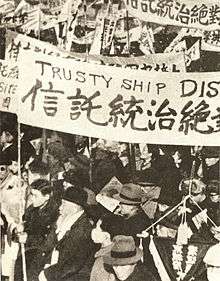
With the American government fearing Soviet expansion, and the Japanese authorities in Korea warning of a power vacuum, the embarkation date of the US occupation force was brought forward three times.[5] On 7 September 1945, General Douglas MacArthur announced that Lieutenant General John R. Hodge was to administer Korean affairs, and Hodge landed in Incheon with his troops the next day. The Provisional Government of the Republic of Korea, which had operated from China, sent a delegation with three interpreters to Hodge, but he refused to meet with them.[26] Likewise, Hodge refused to recognize the newly formed People's Republic of Korea and its People's Committees, and outlawed it on 12 December.[27]
In September 1946, thousands of labourers and peasants rose up against the military government. This uprising was quickly defeated, and failed to prevent scheduled October elections for the South Korean Interim Legislative Assembly.
Ardent anti-communist Syngman Rhee, who had been the first president of the Provisional Government and later worked as a pro-Korean lobbyist in the US, became the most prominent politician in the South. Rhee pressured the American government to abandon negotiations for a trusteeship and create an independent Republic of Korea in the south.[28] On 19 July 1947, Lyuh Woon-hyung, the last senior politician committed to left-right dialogue, was assassinated by a 19-year-old man named Han Chigeun, a recent refugee from North Korea and an active member of a nationalist right-wing group.[29]
The occupation government conducted a number of military campaigns against left-wing insurgents. Over the course of the next few years, between 30,000[30] and 100,000 people were killed.[31]
US–Soviet Joint Commission
In December 1945, at the Moscow Conference, the Allies agreed that the Soviet Union, the US, the Republic of China, and Britain would take part in a trusteeship over Korea for up to five years in the lead-up to independence. Many Koreans demanded independence immediately; however, the Korean Communist Party, which was closely aligned with the Soviet Communist party, supported the trusteeship.[32][33] According to journalist Fyodor Tertitskiy, documentation from 1945 suggests the Soviet government had no plans for a permanent division.[20]
A Soviet-US Joint Commission met in 1946 and 1947 to work towards a unified administration, but failed to make progress due to increasing Cold War antagonism and to Korean opposition to the trusteeship.[34] In 1946, the Soviet Union proposed Lyuh Woon-hyung as the leader of a unified Korea, but this was rejected by the US.[20] Meanwhile, the division between the two zones deepened. The difference in policy between the occupying powers led to a polarization of politics, and a transfer of population between North and South.[35] In May 1946 it was made illegal to cross the 38th parallel without a permit.[36] At the final meeting of the Joint Commission in September 1947, Soviet delegate Terentii Shtykov proposed that both Soviet and US troops withdraw and give the Korean people the opportunity to form their own government. This was rejected by the US.[37]
UN intervention and the formation of separate governments
With the failure of the Joint Commission to make progress, the US brought the problem before the United Nations in September 1947. The Soviet Union opposed UN involvement.[38] The UN passed a resolution on 14 November 1947, declaring that free elections should be held, foreign troops should be withdrawn, and a UN commission for Korea, the United Nations Temporary Commission on Korea (UNTCOK), should be created. The Soviet Union boycotted the voting and did not consider the resolution to be binding, arguing that the UN could not guarantee fair elections. In the absence of Soviet co-operation, it was decided to hold UN-supervised elections in the south only.[39][40] This was in defiance of the report of the chairman of the Commission, K. P. S. Menon, who had argued against a separate election.[41] Some UNTCOK delegates felt that the conditions in the south gave unfair advantage to right-wing candidates, but they were overruled.[42]
The decision to proceed with separate elections was unpopular among many Koreans, who rightly saw it as a prelude to a permanent division of the country. General strikes in protest against the decision began in February 1948.[36] In April, Jeju islanders rose up against the looming division of the country. South Korean troops were sent to repress the rebellion. Tens of thousands of islanders were killed and by one estimate, 70% of the villages were burned by the South Korean troops.[43] The uprising flared up again with the outbreak of the Korean War.[44]
In April 1948, a conference of organizations from the north and the south met in Pyongyang. The southern politicians Kim Koo and Kim Kyu-sik attended the conference and boycotted the elections in the south, as did other politicians and parties.[45][46] The conference called for a united government and the withdrawal of foreign troops.[47] Syngman Rhee and General Hodge denounced the conference.[47] Kim Koo was assassinated the following year.[48]
On 10 May 1948 the south held a general election. It took place amid widespread violence and intimidation, as well as a boycott by opponents of Syngman Rhee.[49] On 15 August, the "Republic of Korea" (Daehan Minguk) formally took over power from the U.S. military, with Syngman Rhee as the first president. In the North, the "Democratic People's Republic of Korea" (Chosŏn Minjujuŭi Inmin Konghwaguk) was declared on 9 September, with Kim Il-sung as prime minister.
On 12 December 1948, the United Nations General Assembly accepted the report of UNTCOK and declared the Republic of Korea to be the "only lawful government in Korea".[50] However, none of the members of UNTCOK considered that the election had established a legitimate national parliament. The Australian government, which had a representative on the commission declared that it was "far from satisfied" with the election.[49]
Unrest continued in the South. In October 1948, the Yeosu–Suncheon Rebellion took place, in which some regiments rejected the suppression of the Jeju uprising and rebelled against the government.[51] In 1949, the Syngman Rhee government established the Bodo League in order to keep an eye on its political opponents. The majority of the Bodo League's members were innocent farmers and civilians who were forced into membership.[52] The registered members or their families were executed at the beginning of the Korean War. On 24 December 1949, South Korean Army massacred Mungyeong citizens who were suspected communist sympathizers or their family and affixed blame to communists.[53]
Korean War
This division of Korea, after more than a millennium of being unified, was seen as controversial and temporary by both regimes. From 1948 until the start of the civil war on 25 June 1950, the armed forces of each side engaged in a series of bloody conflicts along the border. In 1950, these conflicts escalated dramatically when North Korean forces invaded South Korea, triggering the Korean War. The United Nations intervened to protect the South, sending a US-led force. As it occupied the south, the Democratic People's Republic of Korea attempted to unify Korea under its regime, initiating the nationalisation of industry, land reform, and the restoration of the People's Committees.[54]
While UN intervention was conceived as restoring the border at the 38th parallel, Syngman Rhee argued that the attack of the North had obliterated the boundary. Similarly UN Commander in Chief, General Douglas MacArthur stated that he intended to unify Korea, not just drive the North Korean forces back behind the border.[55] However, the North overran 90% of the south until a counter-attack by US-led forces. As the North Korean forces were driven from the south, South Korean forces crossed the 38th parallel on 1 October, and American and other UN forces followed a week later. This was despite warnings from the People's Republic of China that it would intervene if American troops crossed the parallel.[56] As it occupied the north, the Republic of Korea, in turn, attempted to unify the country under its regime, with the Korean National Police enforcing political indoctrination.[57] As US-led forces pushed into the north, China unleashed a counter-attack which drove them back into the south.
In 1951, the front line stabilized near the 38th parallel, and both sides began to consider an armistice. Rhee, however, demanded the war continue until Korea was unified under his leadership.[58] The Communist side supported an armistice line being based on the 38th parallel, but the United Nations supported a line based on the territory held by each side, which was militarily defensible.[59] The UN position, formulated by the Americans, went against the consensus leading up to the negotiations.[60] Initially, the Americans proposed a line that passed through Pyongyang, far to the north of the front line.[61] The Chinese and North Koreans eventually agreed to a border on the military line of contact rather than the 38th parallel, but this disagreement led to a tortuous and drawn-out negotiating process.[62]
Armistice

The Korean Armistice Agreement was signed after three years of war. The two sides agreed to create a 4-kilometre-wide (2.5-mile) buffer zone between the states, known as the Korean Demilitarized Zone (DMZ). This new border, reflecting the territory held by each side at the end of the war, crossed the 38th parallel diagonally. Rhee refused to accept the armistice and continued to urge the reunification of the country by force.[63] Despite attempts by both sides to reunify the country, the war perpetuated the division of Korea and led to a permanent alliance between South Korea and the U.S., and a permanent U.S. garrison in the South.[64]
As dictated by the terms of the Korean Armistice, a Geneva Conference was held in 1954 on the Korean question. Despite efforts by many of the nations involved, the conference ended without a declaration for a unified Korea.
The Armistice established a Neutral Nations Supervisory Commission (NNSC) which was tasked to monitor the Armistice. Since 1953, members of the Swiss[65] and Swedish[66] armed forces have been members of the NNSC stationed near the DMZ. Poland and Czechoslovakia were the neutral nations chosen by North Korea, but North Korea expelled their observers after those countries embraced capitalism.[67]
Post-armistice relations
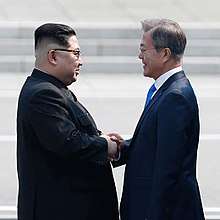
Since the war, Korea has remained divided along the DMZ. North and South have remained in a state of conflict, with the opposing regimes both claiming to be the legitimate government of the whole country. Sporadic negotiations have failed to produce lasting progress towards reunification.[68]
On 27 April 2018 North Korean leader Kim Jong-un and South Korean President Moon Jae-in met in the Demilitarized Zone (DMZ). The Panmunjom Declaration signed by both leaders called for the end of longstanding military activities near the border and the reunification of Korea.[69]
On 1 November 2018, buffer zones were established across the DMZ to help ensure the end of hostility on land, sea and air.[70][71] The buffer zones stretch from the north of Deokjeok Island to the south of Cho Island in the West Sea and the north of Sokcho city and south of Tongchon County in the East (Yellow) Sea.[71][70] In addition, no fly zones were established.[70][71]
In popular culture
Television
- Eyes of Dawn (1991-1992 MBC television series)
- Rustic Period (2002-2003 SBS television series)
- Seoul 1945 (2006 KBS1 television series)
See also
Notes
- "Troops cross North-South Korea Demilitarized Zone in peace for 1st time ever". Cbsnews.com. Retrieved 30 December 2018.
- "North and South Korean soldiers enter each other's territory". The Economic Times. Retrieved 30 December 2018.
- Buzo, Adrian (2002). The Making of Modern Korea. London: Routledge. pp. 31–37. ISBN 978-0-415-23749-9.
- Cumings, Bruce (2005). Korea's Place in the Sun: A Modern History. New York: W. W. Norton & Company. pp. 156–160. ISBN 978-0-393-32702-1.
- Cumings, Bruce (2005). Korea's Place in the Sun: A Modern History. New York: W. W. Norton & Company. pp. 159–160. ISBN 978-0-393-32702-1.
- "Cairo Communique, December 1, 1943". Japan National Diet Library. 1 December 1943. Archived from the original on 6 December 2010. Retrieved 10 November 2012.
- Savada, Andrea Matles; Shaw, William, eds. (1990), "World War II and Korea", South Korea: A Country Study, GPO, Washington, DC: Library of Congress, archived from the original on 29 June 2011, retrieved 16 May 2006
- Cumings, Bruce (2005). Korea's Place in the Sun: A Modern History. New York: W. W. Norton & Company. pp. 187–188. ISBN 978-0-393-32702-1.
- Stueck, William W. (2002), Rethinking the Korean War: A New Diplomatic and Strategic History, Princeton, NJ: Princeton University Press, p. 20, ISBN 978-0-691-11847-5
- Walker, J Samuel (1997). Prompt and Utter Destruction: Truman and the Use of Atomic Bombs Against Japan. Chapel Hill: The University of North Carolina Press. p. 82. ISBN 978-0-8078-2361-3.
- Tertitskiy, Fyodor (6 November 2018). "How Kim Il Sung became North Korea's Great Leader". NK News. Archived from the original on 15 November 2018. Retrieved 15 November 2018.
- Oberdorfer, Don; Carlin, Robert (2014). The Two Koreas: A Contemporary History. Basic Books. p. 5. ISBN 9780465031238.
- Seth, Michael J. (16 October 2010). A History of Korea: From Antiquity to the Present. Rowman & Littlefield Publishers (published 2010). p. 306. ISBN 9780742567177. Archived from the original on 1 January 2016. Retrieved 16 November 2015.
- Buzo, Adrian (2002). The Making of Modern Korea. London: Routledge. p. 53. ISBN 978-0-415-23749-9.
- Goulden, Joseph C (1983). Korea: the Untold Story of the War. New York: McGraw-Hill. p. 17. ISBN 978-0070235809.
- Hyung Gu Lynn (2007). Bipolar Orders: The Two Koreas since 1989. Zed Books. p. 18.
- Seth, Michael J. (2010). A Concise History of Modern Korea: From the Late Nineteenth Century to the Present. Hawaìi studies on Korea. Rowman & Littlefield. p. 86. ISBN 9780742567139. Archived from the original on 19 May 2016. Retrieved 16 November 2015.
- Buzo, Adrian (2002). The Making of Modern Korea. London: Routledge. pp. 53–57. ISBN 978-0-415-23749-9.
- Robinson, Michael E (2007). Korea's Twentieth-Century Odyssey. Honolulu: University of Hawaii Press. pp. 105–106. ISBN 978-0-8248-3174-5.
- Tertitskiy, Fyodor (8 August 2018). "Why Soviet plans for Austria-style unification in Korea did not become a reality". NK News. Archived from the original on 15 November 2018. Retrieved 15 November 2018.
- Buzo, Adrian (2002). The Making of Modern Korea. London: Routledge. pp. 54–55. ISBN 978-0-415-23749-9.
- Robinson, Michael E (2007). Korea's Twentieth-Century Odyssey. Honolulu: University of Hawaii Press. p. 106. ISBN 978-0-8248-3174-5.
- Cumings, Bruce. The Origins of the Korean War: Liberation and the Emergence of Separate Regimes, 1945–1947. Princeton University Press, 1981, 607 pages, ISBN 0-691-09383-0.
- Allan R. Millet, The War for Korea: 1945–1950 (2005) p. 59.
- Gbosoe, Gbingba T. (September 2006). Modernization of Japan. iUniverse (published 2006). p. 212. ISBN 9780595411900. Archived from the original on 28 April 2016. Retrieved 6 October 2015.
Although Soviet occupation forces were withdrawn on December 10, 1948, [...] the Soviets had maintained ties with the Democratic People's Republic of Korea [...]
- Hart-Landsberg, Martin (1998). Korea: Division, Reunification, & U.S. Foreign Policy. Monthly Review Press. pp. 71–77.
- Buzo, Adrian (2002). The Making of Modern Korea. London: Routledge. p. 57. ISBN 978-0-415-23749-9.
- Stueck, William W. (2002). Rethinking the Korean War: A New Diplomatic and Strategic History. Princeton, NJ: Princeton University Press. pp. 49, 55–57. ISBN 978-0-691-11847-5.
- Buzo, Adrian (2002). The Making of Modern Korea. London: Routledge. p. 65. ISBN 978-0-415-23749-9.
- Arthur Millet, The War for Korea, 1945–1950 (2005).
- Jon Halliday and Bruce Cumings, Korea: The Unknown War, Viking Press, 1988, ISBN 0-670-81903-4.
- Buzo, Adrian (2002). The Making of Modern Korea. London: Routledge. p. 59. ISBN 978-0-415-23749-9.
- Bluth, Christoph (2008). Korea. Cambridge: Polity Press. p. 12. ISBN 978-07456-3357-2.
- Buzo, Adrian (2002). The Making of Modern Korea. London: Routledge. pp. 59–60, 65. ISBN 978-0-415-23749-9.
- Robinson, Michael E (2007). Korea's Twentieth-Century Odyssey. Honolulu: University of Hawaii Press. pp. 108–109. ISBN 978-0-8248-3174-5.
- Hyung Gu Lynn (2007). Bipolar Orders: The Two Koreas since 1989. Zed Books. p. 20.
- Pembroke, Michael (2018). Korea: Where the American Century Began. Melbourne: Hardie Grant. p. 43. ISBN 978-1-74379-393-0.
- Lone, Stewart; McCormack, Gavan (1993). Korea since 1850. Melbourne: Longman Cheshire. pp. 100–101.
- Buzo, Adrian (2002). The Making of Modern Korea. London: Routledge. p. 66. ISBN 978-0-415-23749-9.
- Jager, Sheila Miyoshi (2013). Brothers at War – The Unending Conflict in Korea. London: Profile Books. p. 47. ISBN 978-1-84668-067-0.
- Pembroke, Michael (2018). Korea: Where the American Century Began. Melbourne: Hardie Grant. p. 45. ISBN 978-1-74379-393-0.
- Cumings, Bruce (2005). Korea's Place in the Sun: A Modern History. New York: W. W. Norton & Company. pp. 211–212. ISBN 978-0-393-32702-1.
- "Ghosts of Cheju". Newsweek. 19 June 2000. Archived from the original on 15 June 2011. Retrieved 2 September 2012.
- Robinson, Michael E (2007). Korea's Twentieth-Century Odyssey. Honolulu: University of Hawaii Press. pp. 112. ISBN 978-0-8248-3174-5.
- Cumings, Bruce (2005). Korea's Place in the Sun: A Modern History. New York: W. W. Norton & Company. pp. 211, 507. ISBN 978-0-393-32702-1.
- Jager, Sheila Miyoshi (2013). Brothers at War – The Unending Conflict in Korea. London: Profile Books. pp. 47–48. ISBN 978-1-84668-067-0.
- Pembroke, Michael (2018). Korea: Where the American Century Began. Melbourne: Hardie Grant. p. 46. ISBN 978-1-74379-393-0.
- Jager, Sheila Miyoshi (2013). Brothers at War – The Unending Conflict in Korea. London: Profile Books. pp. 48, 496. ISBN 978-1-84668-067-0.
- Pembroke, Michael (2018). Korea: Where the American Century Began. Melbourne: Hardie Grant. p. 47. ISBN 978-1-74379-393-0.
- Buzo, Adrian (2002). The Making of Modern Korea. London: Routledge. p. 67. ISBN 978-0-415-23749-9.
- "439 civilians confirmed dead in Yeosu-Suncheon Uprising of 1948 New report by the Truth Commission places blame on Syngman Rhee and the Defense Ministry, advises government apology". The Hankyoreh. 8 January 2009. Archived from the original on 11 May 2011. Retrieved 2 September 2012.
- "Gov't Killed 3,400 Civilians During War". The Korea Times. 2 March 2009. Archived from the original on 4 October 2012. Retrieved 19 October 2014.
- 두 민간인 학살 사건, 상반된 판결 왜 나왔나?'울산보도연맹' – '문경학살사건' 판결문 비교분석해 봤더니.... OhmyNews (in Korean). 17 February 2009. Archived from the original on 3 May 2011. Retrieved 2 September 2012.
- Lone, Stewart; McCormack, Gavan (1993). Korea since 1850. Melbourne: Longman Cheshire. p. 112.
- Stueck, William W. (2002). Rethinking the Korean War: A New Diplomatic and Strategic History. Princeton, NJ: Princeton University Press. pp. 87–88. ISBN 978-0-691-11847-5.
- Stueck, William W. (2002). Rethinking the Korean War: A New Diplomatic and Strategic History. Princeton, NJ: Princeton University Press. p. 89. ISBN 978-0-691-11847-5.
- Cumings, Bruce (2005). Korea's Place in the Sun: A Modern History. New York: W. W. Norton & Company. pp. 281–282. ISBN 978-0-393-32702-1.
- Stueck, William W. (2002). Rethinking the Korean War: A New Diplomatic and Strategic History. Princeton, NJ: Princeton University Press. p. 141. ISBN 978-0-691-11847-5.
- Stueck, William W. (2002). Rethinking the Korean War: A New Diplomatic and Strategic History. Princeton, NJ: Princeton University Press. pp. 139, 180. ISBN 978-0-691-11847-5.
- Pembroke, Michael (2018). Korea: Where the American Century Began. Hardie Grant Books. pp. 187–188.
- Pembroke, Michael (2018). Korea: Where the American Century Began. Hardie Grant Books. p. 188.
- Pembroke, Michael (2018). Korea: Where the American Century Began. Hardie Grant Books. pp. 188–189.
- Stueck, William W. (2002). Rethinking the Korean War: A New Diplomatic and Strategic History. Princeton, NJ: Princeton University Press. pp. 189–193. ISBN 978-0-691-11847-5.
- Stueck, William W. (2002). Rethinking the Korean War: A New Diplomatic and Strategic History. Princeton, NJ: Princeton University Press. pp. 188–189. ISBN 978-0-691-11847-5.
- "NNSC in Korea" (PDF). Swiss Army. Archived from the original (PDF) on 29 August 2011.
- "Korea". Swedish Armed Forces. Archived from the original on 25 August 2010.
- Winchester, Simon (2015). Pacific: The Ocean of the Future. William Collins. p. 185.
- Feffer, John (9 June 2005). "Korea's slow-motion reunification". Boston Globe. Archived from the original on 23 August 2007. Retrieved 13 August 2007.
- Taylor, Adam (27 April 2018). "The full text of North and South Korea's agreement, annotated". Archived from the original on 12 June 2018. Retrieved 16 May 2018 – via www.washingtonpost.com.
- 이치동 (1 November 2018). "Koreas halt all 'hostile' military acts near border". Yonhap News Agency. Archived from the original on 20 February 2019. Retrieved 28 February 2019.
- "Two Koreas end military drills, begin operation of no-fly zone near MDL: MND - NK News - North Korea News". 31 October 2018. Archived from the original on 1 March 2019. Retrieved 28 February 2019.
References
- Cumings, Bruce. The Origins of the Korean War: Liberation and the Emergence of Separate Regimes, 1945-1947. Princeton University Press, 1981, 607 pages, ISBN 0-691-09383-0
- Fields, David. Foreign Friends: Syngman Rhee, American Exceptionalism, and the Division of Korea. University Press of Kentucky, 2019, 264 pages, ISBN 978-0813177199
- Hoare, James; Daniels, Gordon (February 2004). "The Korean Armistice North and South: The Low-Key Victory [Hoare]; The British Press and the Korean Armistice: Antecedents, Opinions and Prognostications [Daniels]". The Korean Armistice of 1953 and its Consequences: Part I (PDF) (Discussion Paper No. IS/04/467 ed.). London: The Suntory Centre (London School of Economics).
- Lee, Jongsoo. The Partition of Korea After World War II: A Global History. Palgrave Macmillan, 2006, 220 pages, ISBN 978-1-4039-6982-8
- Oberdorfer, Don. The Two Koreas : A Contemporary History. Addison-Wesley, 1997, 472 pages, ISBN 0-201-40927-5
External links
- South Korean Ministry of Unification (Korean and English)
- North Korean News Agency (Korean and English)
- Korea Web Weekly (English)
- NDFSK (Mostly Korean; some English)
- Koreascope (Korean and English)
- Rulers.org, has list of Post-World War II US and Soviet administrators (English)
- Korean Unification Studies